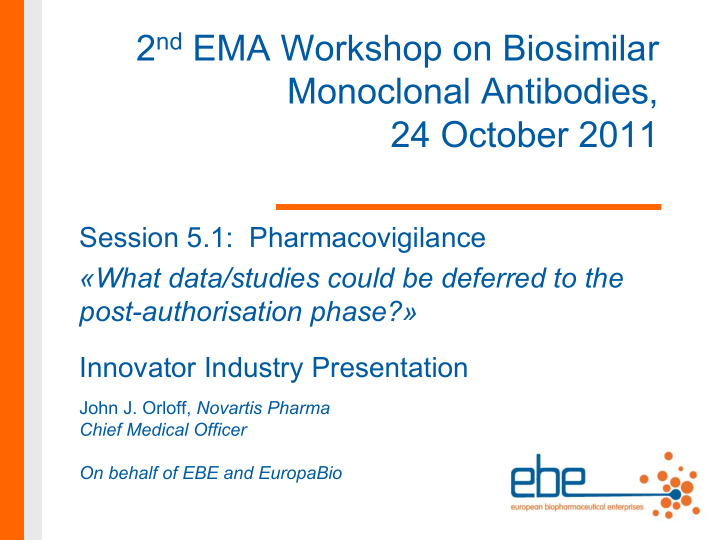



2 nd EMA Workshop on Biosimilar Monoclonal Antibodies, 24 October 2011 Session 5.1: Pharmacovigilance «What data/studies could be deferred to the post-authorisation phase?» Innovator Industry Presentation John J. Orloff, Novartis Pharma Chief Medical Officer On behalf of EBE and EuropaBio
Good pharmacovigilance (PhV) of biosimilar monoclonal antibodies (mAbs): overview Reliable PhV data are key to understanding all biopharmaceutical products Same PhV standards must be applied to both originator and biosimilar mAbs Product/manufacturer identification is critical for mAb adverse event reporting within the framework of the established EU PhV system Post-marketing studies/data required for detection/evaluation of very rare AEs unlikely to be detected in abbreviated pre-approval clinical programs Risk Management Plan required to guide PhV activities (as for all biologics ) 2 | EBE PhV – EMA MAb Workshop | J Orloff | 24OCT2011
Unique product identification of each mAb Required for safety and PhV activities for each biological product Support product identification requirements in new EU PhV legislation: - Product name (proprietary and non-proprietary) - Manufacturer - Lot number To ensure patient safety and accurate labeling, AE reporting must identify responsible product: implementation of appropriate data capture necessary Support requirements to ensure product identification for purposes of tracking and traceability of safety findings 3 | EBE PhV – EMA MAb Workshop | J Orloff | 24OCT2011
Biosimilars: Pharmacovigilance Requirements and Post- authorization Studies Foundational principle: consistent with and based on reference product Biosimilars are highly similar, but not identical, to the reference product based on analytical comparability and abbreviated pre-clinical and clinical programs Pre-approval studies must be of adequate size & duration to establish sufficient comparability to meet biosimilarity criteria Post-approval studies are not a substitute for an adequate pre-approval program to address key safety findings Reference product will have years of post-marketing experience to establish and confirm its safety profile, and to inform PhV and post-authorisation programs for a biosimilar Consideration must be given to the potential for unique properties of the biosimilar molecule, on a case-by-case basis 4 | EBE PhV – EMA MAb Workshop | J Orloff | 24OCT2011
Biosimilars: Pharmacovigilance Requirements and Post- authorization Studies Specific Considerations Target Effects Principles of PhV relating to target profile for biosimilar should be same as for the reference product PhV plan and RMP must take into account the safety experience and evolution of knowledge about the target profile developed during marketed use of the reference product Biosimilar Molecule Complete evaluation of the biosimilar molecule may require additional assessments to identify potentially rare events, such as immunogenicity, hypersensitivity, or other unique findings (data dependent) Where extrapolation to multiple indications is justified based on similar mechanisms of action and the totality of data, additional post-approval indication-specific safety data may or may not* be required *member organizations have somewhat differing views 5 | EBE PhV – EMA MAb Workshop | J Orloff | 24OCT2011
Risk Management Plans for Biosimilar MAbs As in general: the elements of the Plan are proportionate to the anticipated risk, taking into consideration of and further defining benefit-risk Should be based on: - identified risks and knowledge of reference product and product class, e.g. immunogenicity, including knowledge gained during marketed use of the originator, and/or mechanistic class (e.g. TNF inhibitors) - Intrinsic risks of clinical indications and patient populations (including extrapolated indications/patient populations) - pre-approval knowledge of biosimilar product and comparability data, e.g. immunogenicity assessments, results of pre-approval programme 6 | EBE PhV – EMA MAb Workshop | J Orloff | 24OCT2011
Recommend
More recommend